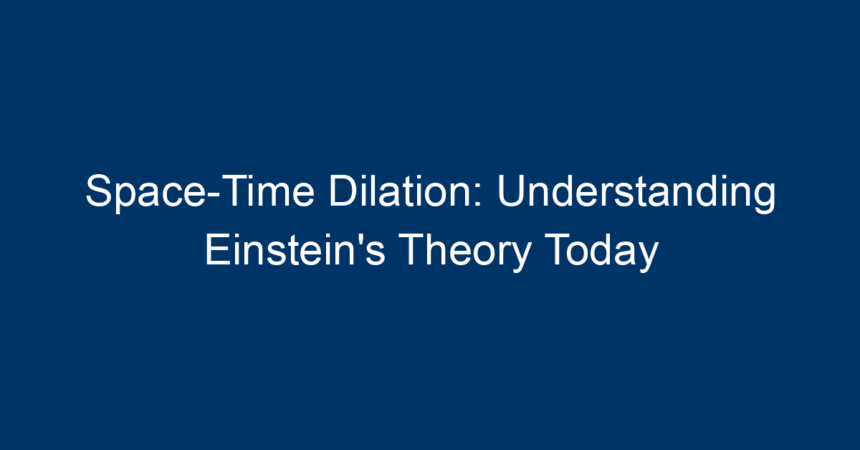Introduction
Imagine you could travel at near-light speed. While you zip through the cosmos, time for you would move slower than for everyone back on Earth. This intriguing phenomenon is known as space-time dilation, a concept rooted in Albert Einstein’s theory of relativity. As we parse the complexities of space-time in our modern world, understanding this principle not only broadens our grasp of the universe but also reshapes our perspective on time and existence itself.
In this article, we will delve deep into space-time dilation, exploring its scientific foundations, real-world applications, and implications for our understanding of the universe. If you’ve ever wondered how time travel may be possible or how high-speed travel affects our perception of time, you’re in the right place!
What is Space-Time Dilation?
The Basics of Space-Time
Before we tackle space-time dilation, it’s essential to understand what we mean by space-time. Simply put, space-time is the four-dimensional continuum that merges the three dimensions of space with the dimension of time. According to Einstein, events that occur can be described by their position in this four-dimensional framework.
Understanding Time Dilation
Time dilation refers to the effect that time can move at different rates for observers under different conditions. Einstein proposed two main theories that account for this phenomenon: special relativity and general relativity.
-
Special Relativity: Introduced in 1905, this theory highlights that time slows down for an object moving close to the speed of light compared to a stationary observer. This is often the most discussed aspect of space-time dilation.
- General Relativity: Proposed in 1915, Einstein expanded upon his initial ideas to include gravity’s effect on the flow of time. Massive objects, like planets and stars, warp the fabric of space-time, leading to varying rates of time passage depending on proximity to mass.
Mathematical Framework of Space-Time Dilation
In a simple equation, time dilation can be expressed as:
[ t’ = \frac{t}{\sqrt{1 – \frac{v^2}{c^2}}} ]
Where:
- ( t’ ) is the time observed by a moving observer.
- ( t ) is the time observed by a stationary observer.
- ( v ) is the velocity of the moving observer.
- ( c ) is the speed of light.
As an object approaches the speed of light (( c )), the time experienced by the moving observer (( t’ )) significantly slows down compared to the stationary observer (( t )).
Real-World Applications of Space-Time Dilation
GPS Technology
One of the most practical applications of space-time dilation is in the Global Positioning System (GPS). Satellites orbiting Earth experience both types of time dilation — special due to their high speeds and general due to their distance from Earth’s gravity.
Without adjusting for these differences in time rates, GPS devices would accumulate errors of up to 10 kilometers each day. The system’s design incorporates the principles of space-time dilation to ensure accurate positioning.
Particle Physics
In experiments conducted at particle accelerators, space-time dilation plays a crucial role. For example, particles known as muons, which are created by cosmic rays hitting the Earth’s atmosphere, have a very short lifespan. When observed moving at near-light speeds, they travel much further than expected before decaying, illustrating real-time effects of space-time dilation.
Astrophysics
Understanding space-time dilation is essential in astrophysics, especially when observing phenomena such as black holes. Close to a black hole, the gravitational forces are immense, and time significantly dilates compared to the rest of the universe — giving rise to the term “event horizon.” This emphasizes how gravity can dramatically affect the passage of time.
Space-Time Dilation and the Concept of Time Travel
The allure of time travel has captivated humanity for centuries, but could space-time dilation make it possible? In theory, if a spaceship could travel at speeds approaching the speed of light, its crew would age slower than those on Earth.
The Twin Paradox
A popular thought experiment illustrating space-time dilation is the twin paradox. Imagine one twin travels through space at near-light speed, while the other remains on Earth. Upon the traveling twin’s return, they would find they have aged less than their Earth-bound sibling — a direct consequence of space-time dilation.
Wormholes and Speculative Physics
While still firmly in the realm of speculation, the idea of using wormholes (a hypothetical passage through space-time) as a means of time travel is a subject of intense study. If real, they could allow travel between distant points in both space and time, challenging our current understanding of physics.
Implications of Space-Time Dilation in Everyday Life
Perception of Time
With ongoing advancements in technology, our perception of time is increasingly being questioned. As we integrate more science fiction into our real-world experiences, concepts of time could evolve, shifting our understanding and expectations.
Philosophical Considerations
Beyond the scientific implications, space-time dilation raises profound philosophical questions. If time differs for individuals based on speed or proximity to mass, what does that mean for our daily lives? How do we measure experiences in a universe where time can flow differently?
Conclusion: Embracing the Wonders of Space-Time Dilation
Space-time dilation may sound like a concept straight out of a science fiction novel, but it has real-world implications that touch our lives in various ways. From GPS technology to profound philosophical considerations, the ideas behind Einstein’s theories continue to ignite curiosity and inspire innovations.
Actionable Insights
-
Stay Informed: As new breakthroughs emerge in physics and technology, understanding principles like space-time dilation can help you appreciate advances in fields such as astrophysics and engineering.
-
Encourage Curiosity: Engage with others about these concepts. Discussions about space-time dilation can lead to exciting conversations about the nature of reality and the universe.
- Explore Further: Dive deeper into the subject! Books, documentaries, and articles can enhance your understanding and appreciation of Einstein’s theories and their far-reaching implications.
Overall, embracing the complexities of space-time dilation encourages us to wonder about the mysteries of the universe and our place within it. Whether through scientific advancement or philosophical debate, the journey into understanding our cosmos continues to be as thrilling as it is enlightening.




